OntoUML Specification 1.0 |
|
OntoUML is an ontologically well-founded UML extension based on the Unified Foundational Ontology (UFO). UFO was created by Giancarlo Guizzardi in his Ph.D. thesis and used to evaluate and re-design a fragment of the UML 2.0 metamodel. Giancarlo Guizzardi is a lead researcher at the Ontology & Conceptual Modeling Research Group (NEMO) located at the Federal University of Espírito Santo (UFES) in Vitória, ES Brazil.
| Prefix | Meta-Properties (MP) |
|---|---|
| +O | Provides identity (Own identity) |
| -O | Does not provides identity |
| +I | Identity |
| -I | No identity |
| +R | Rigid |
| -R | Anti-Rigid |
| ~R | Semi-Rigid |
| +D | Dependent |
| -D | Independent |
| Stereotype | MP | Description |
|---|---|---|

|
+O +I +R -D | A «kind» represents a substance sortal whose instances are functional complexes. Examples include instances of Natural Kinds (such as Person, Dog, Tree) and of artifacts (Chair, Car, Television). |

| Stereotype | MP | Description |
|---|---|---|

|
-O +I +R -D | A «subkind» is a rigid, relationally independent restriction of a substance sortal that carries the principle of identity supplied by it. An example could be the subkind MalePerson of the kind Person. |
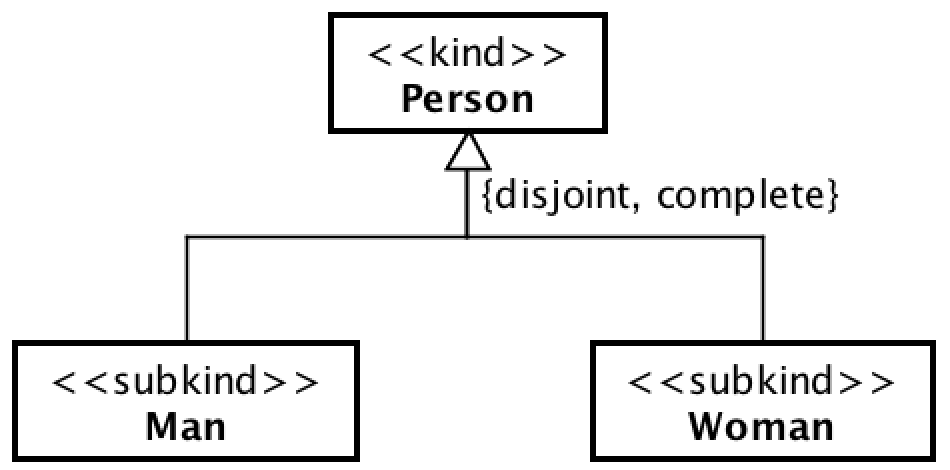
| Stereotype | MP | Description |
|---|---|---|

|
-O +I -R +D | A «role» represents a phased-sortal role, i.e. anti-rigid and relationally dependent universal. For instance, the role student is played by an instance of the kind Person. |

| Stereotype | MP | Description |
|---|---|---|

|
-O +I -R -D | A «phase» represents the phased-sortals phase, i.e. anti-rigid and relationally independent universals defined as part of a partition of a substance sortal. For instance, 〈Catterpillar, Butterfly〉 partitions the kind Lepdopterum. |

| Stereotype | MP | Description |
|---|---|---|

|
+O +I +R -D | A «collective» represents a substance sortal whose instances are collectives, i.e., they are collections of complexes that have a uniform structure. Examples include a deck of cards, a forest, a group of people, a pile of bricks. Collectives can typically relate to complexes via a constitution relation. For example, a pile of bricks that constitutes a wall, a group of people that constitutes a football team. In this case, the collectives typically have an extensional principle of identity, in contrast to the complexes they constitute. For instance, The Beatles was in a given world w constituted by the collective {John, Paul, George, Pete} and in another world w’ constituted by the collective {John, Paul, George, Ringo}. The replacement of Pete Best by Ringo Star does not alter the identity of the band, but creates a numerically different group of people. |
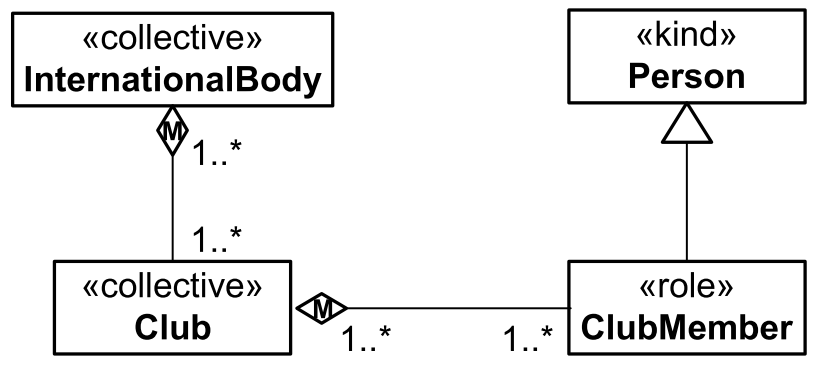
| Stereotype | MP | Description |
|---|---|---|

|
+O +I +R -D | A «quantity» represents a substance sortal whose instances are quantities. Examples are those stuff universals that are typically referred in natural language by mass general terms (e.g., Gold, Water, Sand, Clay). |

| Stereotype | MP | Description |
|---|---|---|

|
-O -I +R -D | A «category» represents a rigid and relationally independent mixin, i.e., a dispersive universal that aggregates essential properties which are common to different substance sortals. For example, the category RationalEntity as a generalization of Person and IntelligentAgent. |

| Stereotype | MP | Description |
|---|---|---|

|
-O -I -R +D | A «roleMixin» represents an anti-rigid and externally dependent non-sortal, i.e., a dispersive universal that aggregates properties which are common to different roles. In includes formal roles such as whole and part, and initiatior and responder. |
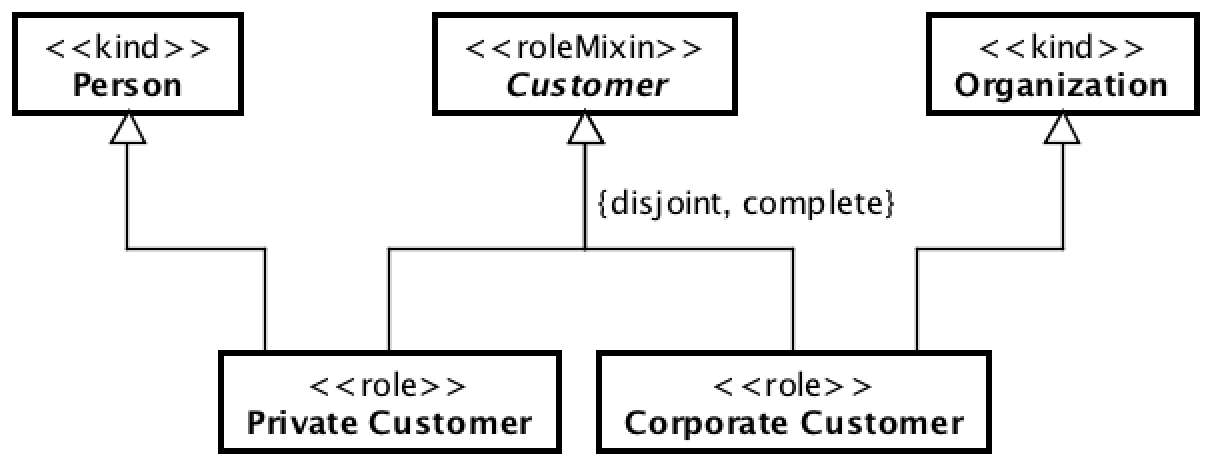
| Stereotype | MP | Description |
|---|---|---|

|
-O -I ~R -D | A «mixin» represents properties which are essential to some of its instances and accidental to others (semi-rigidity). An example is the mixin Seatable, which represents a property that can be considered essential to the kinds Chair and Stool, but accidental to Crate, Paper Box or Rock. |
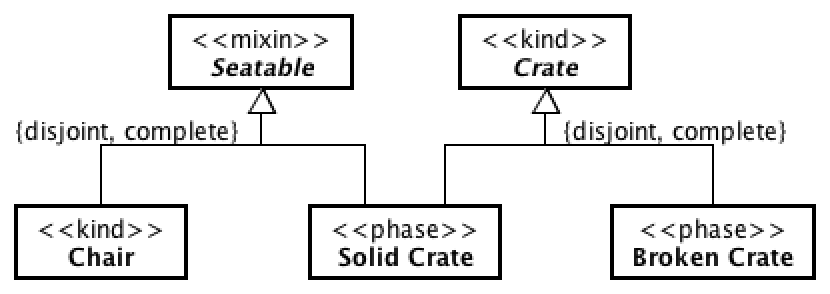
| Stereotype | Description |
|---|---|

|
A «relator» universal is a relational moment universal. Every instance of relator universal is existentially dependent of at least two distinct entities. Relators are the instantiation of relational properties such as marriages, kisses, handshakes, commitments, and purchases. |
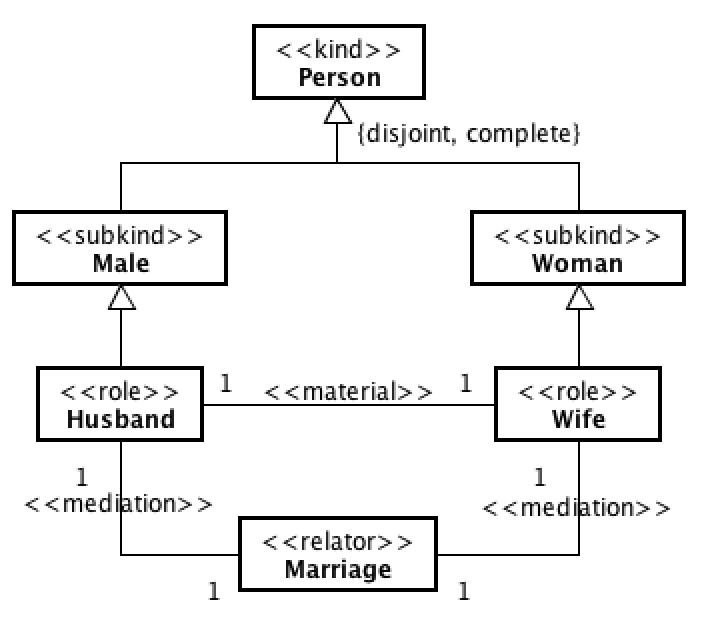
| Stereotype | Description |
|---|---|

|
A «mode» universal is an intrinsic moment universal. Every instance of mode universal is existentially dependent of exactly one entity. Examples include skills, thoughts, beliefs, intentions, symptoms, private goals. |

| Stereotype | Description |
|---|---|

|
A «quality» is defined as an individual (instance) with the power to connect the entity it qualifies (its subject) with a value in a geometric quality space. |

| Stereotype | Description |
|---|---|

|
A «mediation» is a formal relation that takes place between a relator universal and the endurant universal(s) it mediates. For example, the universal Marriage mediates the role universals Husband and Wife, the universal Enrollment mediates Student and University, and the universal Covalent Bond mediates the universal Atom. |
| Constraints | |
|
|
| Stereotype | Description |
|---|---|

|
A «characterization» is a formal relation that takes place between a mode universal and the endurant universal this mode universal characterizes. For example, the universals Private Goal and Capability characterize the universal Agent. |
| Constraints | |
|
|
| Stereotype | Description |
|---|---|

|
A «material» association represents a material relation, i.e., a relational universal which is induced by a relator universal. Examples include student studies in university, patient is treated in medical unit, person is married to person. |
| Constraints | |
|
|
| Stereotype | Description |
|---|---|

|
A «formal» association represents a formal relation, i.e., either a comparative relation (derived from intrinsic properties of the relating entities), or an internal relation. Examples include Person is older than Person, an Atom is heavier than another atom. We use UML symbolic representation for derived relations ( / ) to represent comparative relations. |
| Representation | Description |
|---|---|

|
ComponentOf is a parthood relation between two complexes. Examples include: (a) my hand is part of my arm; (b) a car engine is part of a car; (c) an Arithmetic and Logic Unit (ALU) is part of a Central Process Unit (CPU); (d) a heart is part of a circulatory system. |
| Constraints | |
|
|
| Representation | Description |
|---|---|

|
MemberOf is a parthood relation between a complex or a collective (as a part) and a collective (as a whole). Examples include: (a) a tree is part of forest; (b) a card is part of a deck of cards; (c) a fork is part of cutlery set; (d) a club member is part of a club. |
|
|
| Representation | Description |
|---|---|

|
SubCollectionOf is a parthood relation between two collectives. Examples include: (a) the north part of the Black Forest is part of the Black Forest; (b) The collection of Jokers in a deck of cards is part of that deck of cards; (c) the collection of forks in cutlery set is part of that cutlery set; (d) the collection of male individuals in a crowd is part of that crowd. |
| Constraints | |
|
|
| Representation | Description |
|---|---|

|
SubQuantityOf is a parthood relation between two quantities. Examples include: (a) alcohol is part of Wine; (b) Plasma is part of Blood; (c) Sugar is part of Ice Cream; (d) Milk is part of Cappucino. |
| Constraints | |
|
|
| Representation | Description |
|---|---|

|
A derivation relation represents the formal relation of derivation that takes place between a material relation and the relator universal this material relation is derived from. Examples include the material relation married-to, which is derived from the relator universal Marriage, the material relation kissed-by, derived from the relator universal Kiss, and the material relation purchases-from, derived from the relator universal Purchase. |
| Constraints | |
|
|
| (↓) to (→) | Kind | Quantity | Collective | SubKind | Role | Phase | Category | Mixin | RoleMixin | Relator | Mode | Quality |
| Kind | - | - | - | - | - | - | ✓ | ✓ | - | - | - | - |
| Quantity | - | - | - | - | - | - | ✓ | ✓ | - | - | - | - |
| Collective | - | - | - | - | - | - | ✓ | ✓ | - | - | - | - |
| SubKind | ✓ | ✓ | ✓ | ✓ | - | - | ✓ | ✓ | - | - | - | - |
| Role | ✓ | ✓ | ✓ | ✓ | ✓ | ✓ | - | ✓ | ✓ | ✓ | - | - |
| Phase | ✓ | ✓ | ✓ | ✓ | ✓ | ✓ | - | ✓ | ✓ | ✓ | - | - |
| Category | - | - | - | - | - | - | ✓ | ✓ | - | - | - | - |
| Mixin | - | - | - | - | - | - | ✓ | ✓ | - | - | - | - |
| RoleMixin | - | - | - | - | - | - | ✓ | ✓ | ✓ | - | - | - |
| Relator | - | - | - | - | - | - | - | - | - | ✓ | - | - |
| Mode | - | - | - | - | - | - | - | - | - | - | ✓ | - |
| Quality | - | - | - | - | - | - | - | - | - | - | - | ✓ |
| (↓) to (→) | Kind | Quantity | Collective | SubKind | Role | Phase | Category | Mixin | RoleMixin | Relator | Mode | Quality |
| Kind | cfm | fm | fm | fm | cfm | cfm | cfm | cfm | cfm | dfm | fhm | fhm |
| Quantity | fm | fmq | fm | fm | fm | fm | fm | fm | fm | dfm | fhm | fhm |
| Collective | bfm | fm | bfms | bfm | bcfm | bcfm | bcfm | bcfm | bcfm | dfm | fhm | fhm |
| SubKind | cfm | fm | fm | fm | cfm | cfm | cfm | cfm | cfm | dfm | fhm | fhm |
| Role | cfm | fm | fm | fm | cfm | cfm | cfm | cfm | cfm | dfm | fhm | fhm |
| Phase | cfm | fm | fm | fm | cfm | cfm | cfm | cfm | cfm | dfm | fhm | fhm |
| Category | cfm | fm | fm | fm | cfm | cfm | cfm | cfm | cfm | dfm | fhm | fhm |
| Mixin | cfm | fm | fm | fm | cfm | cfm | cfm | cfm | cfm | dfm | fhm | fhm |
| RoleMixin | cfm | fm | fm | fm | cfm | cfm | cfm | cfm | cfm | dfm | fhm | fhm |
| Relator | dfm | dfm | dfm | dfm | dfm | dfm | dfm | dfm | dfm | bcdfmqs | dfhm | dfhm |
| Mode | fhm | fhm | fhm | fhm | fhm | fhm | fhm | fhm | fhm | dfhm | fhm | fhm |
| Quality | fhm | fhm | fhm | fhm | fhm | fhm | fhm | fhm | fhm | dfhm | fhm | fhm |
| (m)aterial | me(d)iation | (c)omponentOf | sub(q)uantityOf |
| (f)ormal | c(h)aracterization | mem(b)erOf | (s)ubcollectionOf |